Rio de Janeiro, often referred to as the “Marvelous City,” offers a stunning mix of natural beauty, cultural landmarks, and a lively atmosphere. Whether you’re visiting for the first time or the hundredth, there’s always something new to discover. From iconic beaches to breathtaking mountains, here are the 15 best things to do in Rio de Janeiro, Brazil, that you should not miss.

Christ the Redeemer
Address: Tijuca Forest National Park
| Type | Monuments and Memorials, Sightseeing |
| Time to Spend | 2 hours to Half Day |
History and Significance: The Christ the Redeemer statue was completed in 1931 and is an iconic symbol of Rio de Janeiro. Standing 124 feet tall, it represents peace and is recognized as one of the New Seven Wonders of the World. This statue stands atop Corcovado Mountain, offering a breathtaking view of the city.
What to Expect: Expect stunning views of Rio, a chance to explore the panoramic vistas, and plenty of photo opportunities. The statue itself is awe-inspiring, representing faith, peace, and hope.
Visitor Information: The site is open every day from 8:00 AM to 7:00 PM. Tickets can be purchased online or at the site, and it’s best to arrive early to avoid the crowds. The journey to the top involves a train ride followed by a short walk.
A visit to Rio de Janeiro is incomplete without seeing the iconic Christ the Redeemer statue. Standing tall at 124 feet, this monument on Corcovado Mountain offers breathtaking panoramic views of the city. Completed in 1931, Christ the Redeemer is one of the New Seven Wonders of the World. The journey to the top includes a scenic train ride through the Tijuca Forest National Park. To avoid crowds, it’s best to go early in the morning on clear days for the best photos.

Tijuca National Park
Address: Estrada da Cascatinha
| Type | Parks and Gardens |
| Time to Spend | Half Day to Full Day |
History and Significance: Tijuca National Park, established in 1961, is one of the largest urban rainforests in the world. This park plays an important role in preserving Rio’s diverse wildlife and is an environmental sanctuary for species like monkeys and toucans.
What to Expect: The park offers various hiking trails, waterfalls, and scenic viewpoints. Visitors can explore the lush jungle while enjoying peace and tranquility away from the city.
Visitor Information: Tijuca is open daily from 8:00 AM to 5:00 PM. The park’s main entrance is at the Visitor Center. It’s best to wear hiking shoes and bring water. Guided tours are available for those seeking a deeper understanding of the park’s ecosystem.
For nature lovers, Tijuca National Park is a must-visit. This lush rainforest covers over 9,600 acres, making it one of the largest urban forests in the world. It’s home to diverse wildlife, including over 300 species of animals and 1,600 plant varieties. Hiking here offers a peaceful escape from the city’s buzz. Explore waterfalls, caves, and various trails, and don’t forget to stop by the park’s only restaurant, Os Esquilos, for a warm fondue and red wine experience after your hike.

Jardim Botânico
Address: Rua Jardim Botânico
| Type | Parks and Gardens |
| Time to Spend | 2 hours to Half Day |
History and Significance: Founded in 1808, the Rio de Janeiro Botanical Garden (Jardim Botânico) has become a center for plant research and conservation. This lush space holds thousands of plant species and provides valuable insight into Brazil’s diverse flora.
What to Expect: Visitors can stroll along beautiful pathways lined with tropical plants, admire the vibrant orchid garden, and spot wildlife like marmosets and tropical birds.
Visitor Information: Jardim Botânico is open daily from 8:00 AM to 5:00 PM. Entrance fees apply, with discounts for students and locals. The garden also offers guided tours, which are perfect for those interested in plant life and history.
Rio’s Jardim Botânico is a botanical paradise that spans over 350 acres. With more than 7,000 species of plants, the garden is a blend of indigenous and exotic flora, including orchids and Amazonian trees. Originally created in 1808, the garden has become an essential site for research, conservation, and beauty. Visitors can enjoy themed tours, relax in the tranquil surroundings, and explore a range of wildlife, from tropical birds to playful marmosets. Don’t miss the peaceful Garden Café to unwind.

Boat Tours
Address: Rio de Janeiro, Brazil
| Type | Tours, Sightseeing |
| Time to Spend | Half Day to Full Day |
History and Significance: Boat tours in Rio have been a popular way to see the city from the water for decades. They offer unique perspectives of Rio’s beaches, islands, and coastline. The tours are not just sightseeing excursions but are also part of the city’s rich maritime culture.
What to Expect: Expect to enjoy scenic views of Rio’s beaches, iconic landmarks like Sugarloaf Mountain and Christ the Redeemer, and the calm, crystal-clear waters of Guanabara Bay.
Visitor Information: Boat tours are available from morning until evening. It’s advisable to book tickets in advance, especially during peak tourist seasons. Don’t forget sunscreen and a camera to capture the stunning landscapes.
Rio’s stunning coastline and mountainous backdrop are best explored by boat. These boat tours offer a unique view of the city, its beaches, and surrounding islands. Whether you opt for a day-long cruise or a thrilling scuba diving adventure, boat tours provide an unforgettable experience. Popular destinations include Cagarras Island and Arraial do Cabo. If you’re new to diving, don’t worry – trained instructors are there to guide you through the experience, making it suitable for beginners and pros alike.
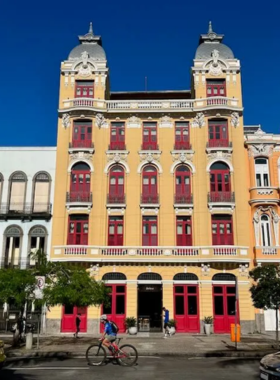
Lapa
Address: Avenida Mem de Sá
| Type | Free, Neighborhood/Area |
| Time to Spend | 1 to 2 hours |
History and Significance: Lapa is a historical district of Rio, famous for its colonial-era architecture, iconic Arcos da Lapa aqueduct, and vibrant nightlife. Once a center for cultural events, Lapa today is a lively hub for music and dance.
What to Expect: Visitors will experience samba, live music, colorful bars, and historic buildings. The area is lively at night, offering entertainment and a glimpse into Rio’s rich cultural heritage.
Visitor Information: Lapa is best visited in the evening when the nightlife is in full swing. It’s easy to reach by metro or taxi, but be cautious at night, as it can get crowded. Most venues charge an entrance fee or cover charge.
Lapa is where the heart of Rio’s nightlife beats. This vibrant neighborhood comes alive at night, filled with samba rhythms and Brazilian music. Bars, clubs, and live music venues line the streets, with the popular Rio Scenarium offering three floors of vintage decor and cocktails. The neighborhood is also home to Leviano and Armazém do Senado, where music ranging from samba to forró fills the air. Whether you’re out for a night of dancing or enjoying the cocktails, Lapa is the place to be.

Ipanema Beach
Address: Avenida Vieira Souto
| Type | Beaches, Free |
| Time to Spend | Half Day to Full Day |
History and Significance: Ipanema Beach is globally known for its association with the famous song “The Girl from Ipanema.” Over the years, it has become a cultural and social landmark in Rio, attracting beachgoers from all over the world.
What to Expect: Expect a lively beach atmosphere with vibrant beach sports, local vendors, and people enjoying the sun. The view of the Dois Irmãos mountains makes it one of the most picturesque beaches in Rio.
Visitor Information: Ipanema Beach is easily accessible by bus or metro. It’s best to visit in the early morning or evening to avoid the midday heat. Don’t forget a hat, sunscreen, and plenty of water to stay hydrated.
Famous worldwide for the song “The Girl from Ipanema,” this beach is a Rio icon. The 1.5-mile stretch of sand is lined with lively activities, from volleyball games to beach vendors offering grilled coalho cheese. With a perfect view of the Dois Irmãos (Two Brothers) mountains, it’s a perfect spot to relax under the Brazilian sun. Locals and tourists alike come here to socialize and enjoy the warm waters. For a magical moment, head to Arpoador to catch the sunset over the horizon.
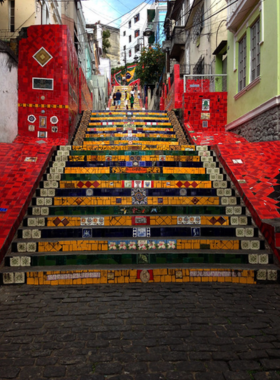
Escadaria Selarón
Address: R. Manuel Carneiro
| Type | Free, Sightseeing |
| Time to Spend | 1 to 2 hours |
History and Significance: Created by Chilean artist Jorge Selarón, the Escadaria Selarón is a colorful staircase that started as a personal tribute to the Brazilian people. This art installation has since become a landmark in Rio, symbolizing unity and global connection.
What to Expect: Expect a dazzling mosaic of over 2,000 brightly colored tiles from around the world. The steps are surrounded by vibrant street art and colorful buildings, making it a photographer’s paradise.
Visitor Information: The Escadaria is free to visit and is open daily. It’s located in the Lapa neighborhood, easily accessible on foot. Be mindful of your belongings, especially in the surrounding area.
The Escadaria Selarón, or Selarón Steps, is a colorful landmark located in the heart of Rio. This 250-step staircase, created by Chilean-born artist Jorge Selarón, is covered in over 2,000 vibrant tiles from around the world. What started as a personal tribute to Brazil’s people has become one of the city’s most photographed landmarks. While it can get crowded, it’s well worth the visit. The area is safe, but it’s wise to keep an eye on your belongings while exploring this beautiful outdoor art installation.

Sugarloaf Mountain (Pão de Açúcar)
Address: 520 Avenida Pasteur, Urca
| Type | Hiking, Sightseeing |
| Time to Spend | 1 to 2 hours |
History and Significance: Sugarloaf Mountain is one of Rio’s most recognizable landmarks, named for its resemblance to the traditional sugarloaf-shaped molds used to form sugar in Brazil. The first cable car ride to the top opened in 1912.
What to Expect: Expect panoramic views of Rio’s stunning coastline, including Copacabana and Ipanema beaches, as well as iconic landmarks like Christ the Redeemer and the bay.
Visitor Information: The cable car operates daily from 8:00 AM to 7:50 PM. Tickets are available at the entrance, and it’s advisable to go early in the day to avoid the crowds. There are plenty of places nearby for food and drinks.
Sugarloaf Mountain, or Pão de Açúcar, is one of Rio’s most iconic sights. Standing 1,296 feet tall, this granite peak offers sweeping views of the city and Guanabara Bay. You can reach the summit via a two-stage cable car ride, enjoying views of the bay, the Christ the Redeemer statue, and the surrounding mountains. Afterward, unwind at Praia Vermelha (Red Beach) or watch the sunset at Mureta, where locals gather to socialize. The Sugarloaf is a perfect blend of adventure and relaxation.

Pedra da Gávea
Address: Barra da Tijuca
| Type | Natural Wonders, Free, Hiking, Recreation |
| Time to Spend | Half Day to Full Day |
History and Significance: Pedra da Gávea is a mountain in Rio de Janeiro that stands as one of the city’s highest peaks. It is considered a challenging hike, but it rewards adventurers with awe-inspiring views.
What to Expect: A strenuous hike up rocky terrain, requiring physical endurance and some climbing assistance. At the summit, you will be treated to a 360-degree view of Rio.
Visitor Information: Hikers should wear proper footwear, bring plenty of water, and consider hiring a guide. The hike typically takes about 4-6 hours, and the peak is best reached in the morning before the heat of the day sets in.
For adventurous travelers, Pedra da Gávea is a must-visit. This towering granite peak rises over 2,700 feet and offers stunning panoramic views of Rio. Hiking to the summit is challenging, involving steep ascents, rocky terrain, and rope-assisted sections. It’s a thrilling experience, but be prepared for a tough trek. Along the way, you’ll encounter incredible wildlife, including monkeys and toucans. Once at the top, you’ll be rewarded with magnificent views of Rio’s coastline, including the Christ the Redeemer statue and Sugarloaf Mountain.
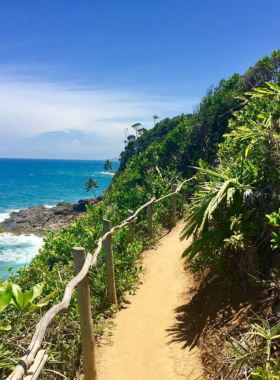
Prainha
Address: Av. Estado Guanabara
| Type | Beaches, Free |
| Time to Spend | Half Day to Full Day |
History and Significance: Prainha is a small but pristine beach located in a protected area, offering a glimpse of Rio’s untouched natural beauty. It’s less crowded, making it a haven for nature lovers and those wanting a more secluded experience.
What to Expect: A beautiful, peaceful beach with natural surroundings, perfect for surfers and sunbathers. The waters here are calm and clear, ideal for a quiet escape.
Visitor Information: Prainha is accessible by car, but public transportation options are limited. It’s a good idea to bring a picnic, as there are no shops nearby. The beach is best enjoyed on weekdays when it’s quieter.
Prainha, often referred to as Rio’s “little beach,” is a hidden gem located about 22 miles from Ipanema. This remote beach is known for its natural beauty, surrounded by hills and lush rainforest. It’s a favorite spot for surfers, thanks to the powerful waves. The beach is quieter during the weekdays, making it an ideal escape from the crowds of Rio’s more popular beaches. Visitors can relax on the golden sand or enjoy the stunning sunsets while surrounded by the tranquility of nature.

Santa Teresa
Address: Praca Pres. Aguirre Cerda
| Type | Free, Neighborhood/Area |
| Time to Spend | 2 hours to Half Day |
History and Significance: Santa Teresa is one of Rio’s most historic neighborhoods, known for its colonial architecture, vibrant street art, and cultural history. It’s often compared to the Montmartre district in Paris due to its artistic atmosphere.
What to Expect: Strolling through cobblestone streets filled with art galleries, small cafes, and cultural sites, Santa Teresa offers a bohemian vibe. It’s also home to stunning views of the city.
Visitor Information: Santa Teresa is best explored on foot. The area is relatively safe but always be cautious with valuables. It’s easy to get there by tram or taxi, with several landmarks and galleries to explore.
Santa Teresa is a charming neighborhood that offers a unique blend of old-world Rio and modern artistic vibes. Known for its narrow, winding streets and colonial-style homes, it’s a bohemian area that attracts artists, musicians, and travelers. Wander through its lively streets, where you’ll find cozy cafes, local art galleries, and beautiful views of the city. In addition to its artistic culture, Santa Teresa offers some great local bars and restaurants, making it a perfect place to enjoy the authentic flavors of Rio.

Maracanã Stadium
Address: R. Prof. Eurico Rabelo – Maracanã, Rio de Janeiro – RJ, 20271-150, Brazil
| Type | Stadium, Sports |
| Time to Spend | 2 hours to Half Day |
History and Significance: Maracanã Stadium, opened in 1950, has hosted some of the most significant sporting events, including the 2014 FIFA World Cup. The stadium holds a special place in Brazilian football history.
What to Expect: Expect to experience the passion and energy of Brazilian football culture. You can tour the stadium, visit the locker rooms, and learn about its rich history through exhibits.
Visitor Information: Tours are available every day except on match days. Be sure to check the stadium’s schedule for events. You can reach Maracanã easily by metro or bus, with guided tours available for in-depth experiences.
A visit to Maracanã Stadium is essential for sports enthusiasts visiting Rio. This iconic venue has hosted some of the world’s biggest sporting events, including the 1950 World Cup and the 2014 FIFA World Cup final. Whether you’re a football fan or not, the stadium’s history is fascinating. You can take a guided tour of the stadium, learning about its role in Brazilian sports culture and experiencing its impressive atmosphere. If you’re in town during match season, catching a game is a thrilling way to experience Rio’s passion for football.
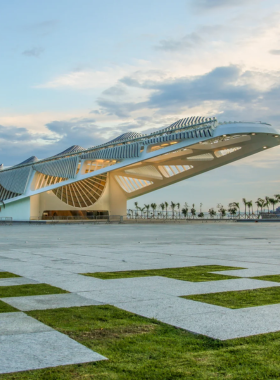
Museum of Tomorrow
Address: Praça Mauá, 1 – Centro, Rio de Janeiro – RJ, 20081-240, Brazil
| Type | Museum |
| Time to Spend | Half Day |
History and Significance: The Museum of Tomorrow, designed by architect Santiago Calatrava, opened in 2015 as a cultural space focused on science, technology, and the future. It explores the challenges and opportunities humanity faces in the coming years.
What to Expect: Expect interactive exhibits on climate change, sustainability, and technological innovation. The museum’s futuristic architecture and unique exhibits are as impressive as the content.
Visitor Information: The museum is open Tuesday to Sunday from 10:00 AM to 5:00 PM. Tickets are available online and at the entrance. It’s best to arrive early to avoid crowds, especially during weekends.
Rio’s Museum of Tomorrow is a striking piece of modern architecture located in the city’s revitalized port area. This science museum focuses on sustainability and the future of the planet, with interactive exhibits that explore everything from climate change to technological advancements. The museum’s futuristic design stands out against the backdrop of Rio’s historical buildings. Whether you’re a science enthusiast or simply looking for a unique experience, the Museum of Tomorrow offers an educational and visually stunning glimpse into what lies ahead.
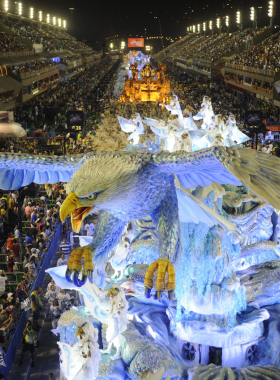
Rio Carnival
Address: Rio de Janeiro, Brazil
| Type | Neighborhood area, Festivals, street parties |
| Time to Spend | 2 hours to Half Day |
History and Significance: The Rio Carnival is the world’s largest carnival, celebrated since the 18th century. It’s an essential part of Rio’s cultural identity, featuring vibrant parades, music, and dancing in the streets.
What to Expect: Expect to be swept away by the colors, music, and energy. Samba schools put on dazzling parades, and street parties take over the entire city.
Visitor Information: Rio Carnival typically takes place in February or March, depending on when Easter falls. Tickets for the Sambadrome parade can be purchased in advance. Ensure you plan accommodations early, as the city is packed during this period.
The Rio Carnival is one of the world’s most famous festivals, attracting millions of visitors each year. This vibrant celebration features parades, street parties, and endless samba music, creating a lively and electric atmosphere across the city. The main event is the Sambadrome Parade, where samba schools compete in colorful and elaborate floats. If you’re lucky enough to visit during Carnival season, you’ll be swept up in the infectious energy of the event. Prepare for fun, excitement, and an unforgettable cultural experience.

Copacabana Beach at Sunset
Address: Avenida Atlântica, Zona Sul
| Type | Beaches, Free |
| Time to Spend | Half Day to Full Day |
History and Significance: Copacabana Beach is a cultural and social symbol of Rio. Known for its 4-kilometer stretch of golden sand, the beach has been a gathering place for both locals and tourists for generations.
What to Expect: Expect to see a beautiful sunset, with the sun sinking behind the Dois Irmãos mountains. It’s a peaceful moment, perfect for watching the changing colors of the sky and the calm waves.
Visitor Information: Copacabana Beach is accessible by bus or metro. It’s safe to visit any time of day, but the sunset is an ideal time to enjoy the beauty. Take a stroll along the promenade and stop at one of the many beachfront cafes.
Copacabana Beach is one of Rio’s most famous and beautiful beaches, known for its long stretch of golden sand and lively atmosphere. However, the real magic happens at sunset. As the sun sets behind the Dois Irmãos mountains, the sky is painted in hues of orange and pink, offering a breathtaking view. The beach comes alive with locals and tourists gathering to watch this stunning natural display. Whether you’re relaxing on the sand or enjoying a drink at one of the nearby cafes, watching the sunset here is an unforgettable experience.
